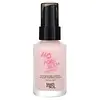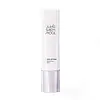What's inside
What's inside
 Key Ingredients
Key Ingredients

 Benefits
Benefits

 Concerns
Concerns

 Ingredients Side-by-side
Ingredients Side-by-side

Cyclopentasiloxane
EmollientWater
Skin ConditioningDimethicone
EmollientDimethicone/Vinyl Dimethicone Crosspolymer
Skin ConditioningPEG-10 Dimethicone
Skin ConditioningDimethicone Crosspolymer
Emulsion StabilisingDipropylene Glycol
HumectantSilica
AbrasivePhenoxyethanol
PreservativeDisteardimonium Hectorite
StabilisingMagnesium Sulfate
Parfum
MaskingMethyl Methacrylate Crosspolymer
CI 77891
Cosmetic ColorantEthylhexylglycerin
Skin ConditioningDisodium EDTA
Aluminum Hydroxide
EmollientStearic Acid
CleansingButylene Glycol
HumectantCI 77491
Cosmetic ColorantSoluble Collagen
HumectantCI 73360
Cosmetic ColorantCamellia Sinensis Leaf Extract
AntimicrobialTriethoxycaprylylsilane
Cyclopentasiloxane, Water, Dimethicone, Dimethicone/Vinyl Dimethicone Crosspolymer, PEG-10 Dimethicone, Dimethicone Crosspolymer, Dipropylene Glycol, Silica, Phenoxyethanol, Disteardimonium Hectorite, Magnesium Sulfate, Parfum, Methyl Methacrylate Crosspolymer, CI 77891, Ethylhexylglycerin, Disodium EDTA, Aluminum Hydroxide, Stearic Acid, Butylene Glycol, CI 77491, Soluble Collagen, CI 73360, Camellia Sinensis Leaf Extract, Triethoxycaprylylsilane
Water
Skin ConditioningCyclopentasiloxane
EmollientTrimethylsiloxysilicate
EmollientAlcohol Denat.
AntimicrobialMethyl Methacrylate Crosspolymer
PEG-10 Dimethicone
Skin ConditioningSynthetic Fluorphlogopite
Butylene Glycol
HumectantCaprylyl Methicone
Skin ConditioningCetyl Ethylhexanoate
EmollientPentylene Glycol
Skin ConditioningTriethylhexanoin
MaskingDisteardimonium Hectorite
StabilisingGlycerin
HumectantAluminum Starch Octenylsuccinate
AbsorbentDiphenylsiloxy Phenyl Trimethicone
Skin ConditioningLauryl PEG-8 Dimethicone
Silica
AbrasiveMagnesium Sulfate
Tribehenin
EmollientPhenoxyethanol
PreservativeVinyldimethicone
PEG-Crosspolymer
CI 77891
Cosmetic ColorantTriethoxycaprylylsilane
Ethylhexylglycerin
Skin ConditioningParfum
MaskingAluminum Hydroxide
EmollientStearic Acid
CleansingDisodium EDTA
Ethylhexyl Palmitate
EmollientSodium PCA
HumectantMagnesium PCA
HumectantZinc PCA
HumectantSilica Dimethyl Silylate
EmollientCaprylyl Glycol
EmollientManganese PCA
HumectantPotassium Sorbate
PreservativeSodium Hyaluronate
HumectantHexylene Glycol
EmulsifyingGossypium Herbaceum Seed Extract
Skin ConditioningWater, Cyclopentasiloxane, Trimethylsiloxysilicate, Alcohol Denat., Methyl Methacrylate Crosspolymer, PEG-10 Dimethicone, Synthetic Fluorphlogopite, Butylene Glycol, Caprylyl Methicone, Cetyl Ethylhexanoate, Pentylene Glycol, Triethylhexanoin, Disteardimonium Hectorite, Glycerin, Aluminum Starch Octenylsuccinate, Diphenylsiloxy Phenyl Trimethicone, Lauryl PEG-8 Dimethicone, Silica, Magnesium Sulfate, Tribehenin, Phenoxyethanol, Vinyldimethicone, PEG-Crosspolymer, CI 77891, Triethoxycaprylylsilane, Ethylhexylglycerin, Parfum, Aluminum Hydroxide, Stearic Acid, Disodium EDTA, Ethylhexyl Palmitate, Sodium PCA, Magnesium PCA, Zinc PCA, Silica Dimethyl Silylate, Caprylyl Glycol, Manganese PCA, Potassium Sorbate, Sodium Hyaluronate, Hexylene Glycol, Gossypium Herbaceum Seed Extract
Ingredients Explained
These ingredients are found in both products.
Ingredients higher up in an ingredient list are typically present in a larger amount.
Aluminum Hydroxide is a form of aluminum. It can be naturally found in nature as the mineral gibbsite. In cosmetics, Aluminum Hydroxide is used as a colorant, pH adjuster, and absorbent.
As a colorant, Aluminum Hydroxide may add opacity, or reduce the transparency. Aluminum hydroxide is contains both basic and acidic properties.
According to manufacturers, this ingredient is an emollient and humectant. This means it helps hydrate the skin.
In medicine, this ingredient is used to help relieve heartburn and help heal ulcers.
There is currently no credible scientific evidence linking aluminum hydroxide in cosmetics to increased cancer risk.
Major health organizations allow the use of aluminum hydroxide in personal care products and have not flagged it as a carcinogenic risk at typical usage levels.
Learn more about Aluminum HydroxideButylene Glycol (or BG) is used within cosmetic products for a few different reasons:
Overall, Butylene Glycol is a safe and well-rounded ingredient that works well with other ingredients.
Though this ingredient works well with most skin types, some people with sensitive skin may experience a reaction such as allergic rashes, closed comedones, or itchiness.
Learn more about Butylene GlycolCi 77891 is a white pigment from Titanium dioxide. It is naturally found in minerals such as rutile and ilmenite.
It's main function is to add a white color to cosmetics. It can also be mixed with other colors to create different shades.
Ci 77891 is commonly found in sunscreens due to its ability to block UV rays.
Learn more about CI 77891Cyclopentasiloxane, or D5, is a silicone used to improve texture of products and trap moisture.
D5 is considered lightweight and volatile. Volatile means it evaporates quickly after application. Once evaporated, D5 leaves a thin barrier that helps keep skin hydrated.
It is also an emollient. Emollients help soften the skin and prevent water loss. Silicones create a silky texture in products. D5 helps other ingredients become more spreadable.
Studies show D5 is safe to use in skincare products. We recommend speaking with a skincare professional if you have concerns.
Learn more about CyclopentasiloxaneDisodium EDTA plays a role in making products more stable by aiding other preservatives.
It is a chelating agent, meaning it neutralizes metal ions that may be found in a product.
Disodium EDTA is a salt of edetic acid and is found to be safe in cosmetic ingredients.
Learn more about Disodium EDTADisteardimonium Hectorite comes from the clay mineral named hectorite. It is used to add thickness to a product.
It can also help stabilize a product by helping to disperse other ingredients.
Hectorite is a rare, white clay mineral.
Learn more about Disteardimonium HectoriteEthylhexylglycerin (we can't pronounce this either) is commonly used as a preservative and skin softener. It is derived from glyceryl.
You might see Ethylhexylglycerin often paired with other preservatives such as phenoxyethanol. Ethylhexylglycerin has been found to increase the effectiveness of these other preservatives.
Magnesium Sulfate is a salt. More specifically, it is an epsom salt, or the bath salt used to help relieve muscle aches.
Despite having ‘sulfate’ in the name, it isn’t a surfactant or cleansing agent like sodium lauryl sulfate. Unlike those sulfates, magnesium sulfate doesn’t have the same cleansing or foaming properties (it's simply a type of salt).
In cosmetics, Magnesium Sulfate is used to thicken a product or help dilute other solids. It is a non-reactive and non-irritating ingredient.
One study shows magnesium deficiency may lead to inflammation of the skin. Applying magnesium topically may help reduce inflammation.
You can find this ingredient in sea water or mineral deposits.
Learn more about Magnesium SulfateThis ingredient comes as a powder made up of small, porous, microbeads. It is used to add a silky feel to products and also helps absorb oil.
Parfum is a catch-all term for an ingredient or more that is used to give a scent to products.
Also called "fragrance", this ingredient can be a blend of hundreds of chemicals or plant oils. This means every product with "fragrance" or "parfum" in the ingredients list is a different mixture.
For instance, Habanolide is a proprietary trade name for a specific aroma chemical. When used as a fragrance ingredient in cosmetics, most aroma chemicals fall under the broad labeling category of “FRAGRANCE” or “PARFUM” according to EU and US regulations.
The term 'parfum' or 'fragrance' is not regulated in many countries. In many cases, it is up to the brand to define this term.
For instance, many brands choose to label themselves as "fragrance-free" because they are not using synthetic fragrances. However, their products may still contain ingredients such as essential oils that are considered a fragrance by INCI standards.
One example is Calendula flower extract. Calendula is an essential oil that still imparts a scent or 'fragrance'.
Depending on the blend, the ingredients in the mixture can cause allergies and sensitivities on the skin. Some ingredients that are known EU allergens include linalool and citronellol.
Parfum can also be used to mask or cover an unpleasant scent.
The bottom line is: not all fragrances/parfum/ingredients are created equally. If you are worried about fragrances, we recommend taking a closer look at an ingredient. And of course, we always recommend speaking with a professional.
Learn more about ParfumPeg-10 Dimethicone is silicone with conditioner and emulsifier properties. It mostly acts as an emollient in skincare and and humectant in haircare.
According to the manufacturer, acidic formulations decrease the stability of this ingredient. It works best in neutral or near neutral formulations.
Phenoxyethanol is a preservative that has germicide, antimicrobial, and aromatic properties. Studies show that phenoxyethanol can prevent microbial growth. By itself, it has a scent that is similar to that of a rose.
It's often used in formulations along with Caprylyl Glycol to preserve the shelf life of products.
Silica, also known as silicon dioxide, is a naturally occurring mineral. It is used as a fine, spherical, and porous powder in cosmetics.
Though it has exfoliant properties, the function of silica varies depending on the product.
The unique structure of silica enhances the spreadability and adds smoothness, making it a great texture enhancer.
It is also used as an active carrier, emulsifier, and mattifier due to its ability to absorb excess oil.
In some products, tiny microneedles called spicules are made from silica or hydrolyzed sponge. When you rub them in, they lightly polish away dead skin layers and enhance the penetration of active ingredients.
Learn more about SilicaStearic Acid is a fatty acid. It is an emollient, emulsifier, and texture enhancer.
As an emollient, stearic acid helps soften skin. It aids the skin's protective barrier by preventing water loss. It also provides a gentle cleansing effect without stripping away natural oils.
Stearic acid may also be used to enhance the texture of products. It can add volume and stabilize ingredients such as water and oil. This can help water and oil ingredients from separating.
Sources of stearic acid include animal or vegetable fats/oils such as coconut or shea. It can be naturally found in butter, cocoa butter, shea butter, vegetable fats, and animal tallow.
This ingredient may not be Malassezia folliculitis, or fungal-acne safe.
Learn more about Stearic AcidTriethoxycaprylylsilane is a silicone used to bind and stabilize ingredients.
As an emulsifier, it helps prevent ingredients from separating. This can help elongate the shelf life of products.
Triethoxycaprylylsilane is often used to coat mineral sunscreens ingredients to help give a better feel. It also helps reduce oxidative stress in sunscreens.
Learn more about TriethoxycaprylylsilaneWater. It's the most common cosmetic ingredient of all. You'll usually see it at the top of ingredient lists, meaning that it makes up the largest part of the product.
So why is it so popular? Water most often acts as a solvent - this means that it helps dissolve other ingredients into the formulation.
You'll also recognize water as that liquid we all need to stay alive. If you see this, drink a glass of water. Stay hydrated!
Learn more about Water